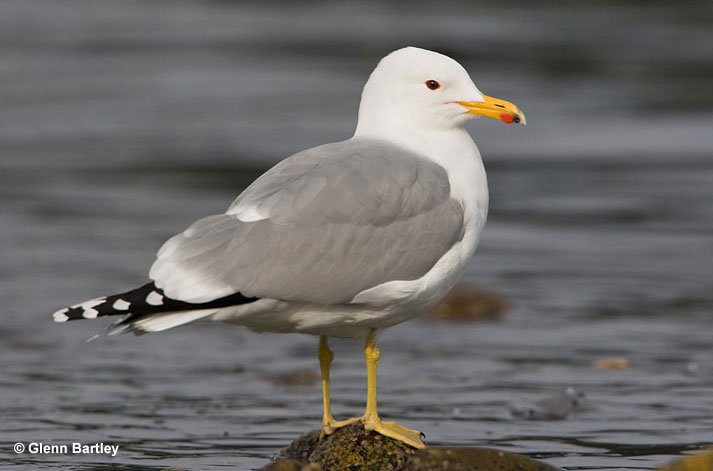
Utah is in the mountain division’s western portion of the United States. The terrain consists of arid deserts, pine forests, and mountain valleys. It’s a larger state with a population of 3.338 million and an 84,899 sq mile size.
Utah state bird is the California Gull. These birds can be found throughout the western portions of the United States.
On this page
Why is the California Gull the State Bird of Utah?
The California Gull officially became the state bird of Utah in February 1955.
In 1848, the California gull emerged as the savior of the state’s inhabitants. This is because, during that year, a devastating horde of Rocky Mountain crickets invaded, ravaging the crops of Utah’s farmers and jeopardizing the local food supply in an era when food transportation was entirely reliant on rail cars and horseback.
These gulls quickly became the hero, feasting upon the relentless crickets. Their voracious appetite helped get rid of these pests, protecting what remained of the crops and securing the state’s food resources.
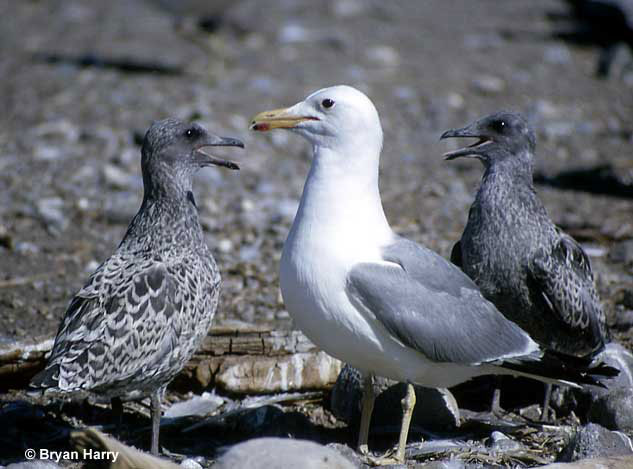
Fun Facts about California Gulls
- Chicks enjoy playing with sticks; they’ll pick sticks up, drop them, and then pick them up again. They also do this to help them learn how to catch prey in flight! They’ll drop a stick in midair and swoop down to catch it.
- The oldest recorded California Gull lived to be at least 28 years and 3 months old. It was initially banded in California in 1985; it was caught in 2013 in the same state due to an injury.
- The California Gull is an opportunist; they’ll eat anything it can scavenge or catch. It has an odd foraging strategy as well. To catch alkali flies that congregate on the shores of salty lakes, it starts at one end of a massive raft of flies and runs through them with its head down and bill open, grabbing them along the way.
- California Gulls are typically found near saline lakes.
- California gulls prefer cherries. They’ve been seen beating cherries off the trees and eating the fallen berries off the ground.
- California Gulls are omnivores and will feed on a wide variety of items, including fruit, carrion, frogs, small lizards, crustaceans, earthworms, small mammals, young birds, eggs, fish, and insects.
- To encourage earthworms to come to the surface, gull flocks will trick them by stamping their feet to convince the worms it’s raining.
- California gulls have an interesting adaptation. The second claw, located partially up their legs, helps the birds maintain their balance. They’re why strong winds do not blow away gulls when sitting on elevated surfaces.
Identification
The California Gull is a medium-sized gull with a round head, slender bill, and long, pointed wings. California Gulls are smaller than a Herring Gull and larger than a Ring-billed Gull.
Adult male and adult female California Gulls look similar. They have white heads, light gray backs, yellow legs, and dark eyes.
Nonbreeding adults have brown streaking on their heads.
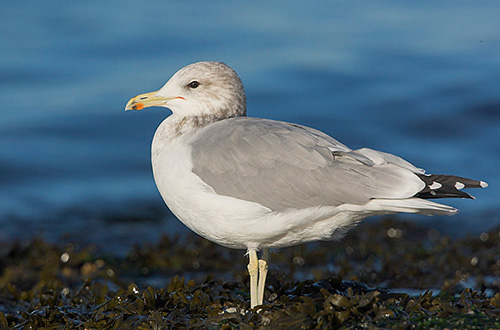
Copyright Glenn Bartley
Adult birds have a yellow bill with a small black ring and a red spot on the lower mandible. The mandible gets brighter during the breeding season.
In their first year of life, these birds are mottled white and brown and often have paler faces.
The bill is pink with a black tip, and the legs are pinkish as well. Second-year California Gulls are also mottled brown but begin to show some gray plumage on the back. They have bluish legs and dark eyes. Third-year gulls look very similar to adults.
Two different subspecies of California Gull exist. The gulls that breed in the Great Plains are larger and paler, while gulls that breed in the Great Basin region of the western U.S. have darker backs and are smaller in size.
What do California Gulls eat?
California Gulls are omnivores. They’ll readily consume a wide array of items they can grab with their beaks. Their diet involves fish, grasshoppers, brine shrimp, mayflies, earthworms, cherries, diminutive mammals, avian eggs, carrion, grains, and more.
Related: What does it mean when a bird poops on you?
They also have diverse foraging techniques, including scavenging on the ground, pursuing airborne insects, plucking prey from the water’s surface, and performing aquatic dives to capture fish.
Call
California Gulls are very vocal birds, but they don’t have any songs that are true to them. Nonetheless, they are notably expressive even during nocturnal hours within their breeding colonies. A raspy, hoarse series of notes characterize their calls. These calls serve distinct purposes, each aligned with specific behaviors: the alarm call, long call, warning call, alarm call, and choking call.
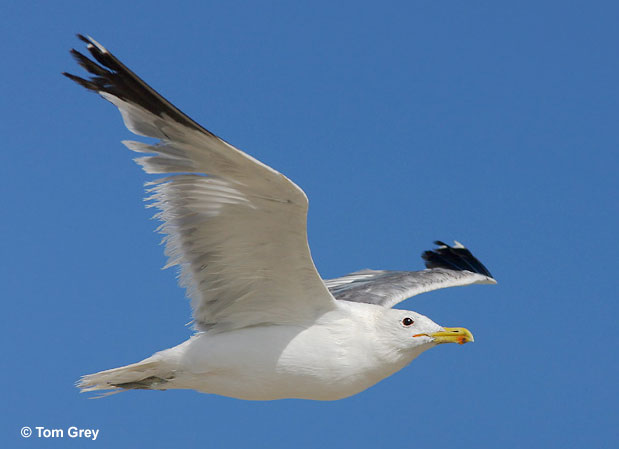
The “long call,” employed primarily during territorial defense, starts with a lowered head, climaxing in a forceful upward raise of the head accompanied by a resounding aow. The “choking call,” commonly utilized before and during nest building, involves placing their breast on the ground while executing a rhythmic head movement resembling choking.
During flight, California Gulls issue a prolonged, resonant yeow as a “warning call,” notably when taking flight from their breeding colonies. When confronting potential threats, they emit the “alarm call,” a series of sharp ha ha ha ha notes, typically while airborne, often in response to predator detection.
In terms of pitch, their vocalizations fall within an intermediate range, distinguishing them from the higher-pitched calls of Ring-billed Gulls and the lower-pitched calls of Herring Gulls, such as Ring-billed Gulls being higher-pitched and Herring Gulls being lower-pitched by comparison.
Behavior
California Gulls exhibit remarkable versatility on land, in the air, and on the water. They can be seen swimming, flying, and running to capture food. On their breeding grounds, they often engage in high-speed pursuits through swarms of flies with their bills wide open. In aquatic areas, they demonstrate both paddling behaviors similar to ducks and diving maneuvers to capture fish.
During moments of rest, these gulls commonly position themselves on one leg or sit with their legs tucked beneath them, eyes gently closed.
They are social in nature, which leads them to associate with fellow gulls frequently.
Nevertheless, even within their highly social gatherings, they exhibit territorial instincts, defending their nesting areas within breeding colonies.
Intruders are met with a series of intimidation tactics, including elongating their necks upright, thrusting their heads forward while opening their bills, and jerking their heads upward and then downward towards their chests while vocalizing.
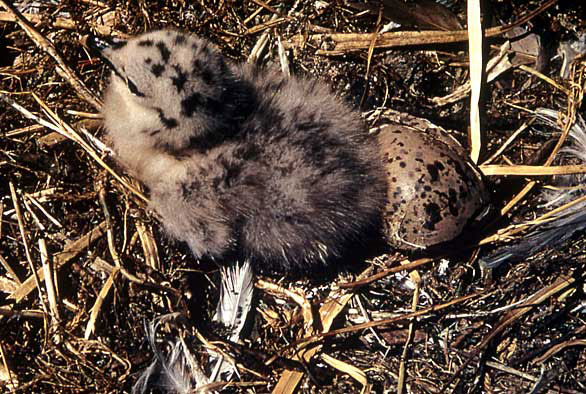
In instances where neighboring gulls encroach upon territorial boundaries, confrontations ensue, often involving aggressive actions such as biting at grass or vegetation as a declaration of ownership.
California Gulls engage in monogamous pair bonding when they reach 4 years of age, with some pairs staying together beyond a single breeding season.
During the courtship and mating process, each bird performs a distinctive head-tossing gesture, arching its head up and over its back while offering food to its mate. As part of their courtship rituals, they engage in a “choking display,” characterized by placing their breasts on the ground and rhythmically jerking their heads up and down, resembling the act of choking.
Other Bird Species in Utah
Utah isn’t just known for its seagulls, there are many other bird species in Utah.
Here are the brightest examples:
- American Robin
- House Finch
- Mallard
- Common Raven
- Black-billed Magpie
- European Starling
- Song Sparrow
See more – common bird species in Utah
Frequently Asked Questions
Why is the state bird of Utah a seagull?
The California Gull is the state bird of Utah because, in 1855, the bird helped save the state’s crops. A devastating horde of Rocky Mountain crickets invaded, ravaging the crops of Utah. These gulls consumed the crickets and helped get rid of the pests.
What does seagull mean in Native American?
In Native American culture, seagulls are commonly viewed as messengers from the spiritual world. They deliver insight and guidance to those who are looking for it.
Why is the seagull so important?
Seagulls are important for the environment. They’re omnivores and don’t mind eating food waste found in landfills. This reduces the amount of ammonia and methane released into the atmosphere, which, in short, makes the air cleaner.
Why do seagulls stand in the rain?
Seagulls will stand upright when facing the rain with their beaks facing forward. This position helps conserve energy and reduces how much contact the rain has with their bodies.
More in Utah: Most common birds | Hawks

